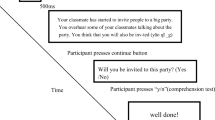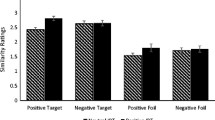Abstract
Depression has been widely associated with a cognitive deficit leading to the negative interpretation of ambiguous information. Recently, cognitive bias modification (CBM) procedures have shown that such negative biases are causally related to emotional vulnerability. However, research using CBM has been notably lacking in depression. This is the first double blind randomised controlled study investigating the effect of cognitive bias modification-errors (CBM-errors), on depression and its influence on mood and resilience to stress. CBM-errors is a new form of cognitive bias modification for interpretation, which targets the full range of cognitive errors, as well as interpretation biases. Forty clinically depressed participants were randomly allocated to a positive training group or neutral text reading control group. Participants trained to make positive interpretations subsequently interpreted novel ambiguous information in a positive manner compared to controls. The results suggest that a positive cognitive bias can be induced in clinically depressed individuals using a simple computerised intervention. There was little evidence of corresponding benefits in terms of mood or response to stress, suggesting that multiple sessions are likely to be needed to confer symptom related change. A systematic investigation of the optimum number and timing of multiple sessions is now called for.



Similar content being viewed by others
Notes
Arbitrary inference, selective abstraction, minimization, dichotomous thinking, overgeneralisation, personalization, catastrophising/magnification.
Subsequent analyses performed at the request of an anonymous reviewer and reinstating both participants did not alter the pattern of the results reported on any measure.
One participant had missing data on this measure.
Three participants had missing data on this measure.
Three participants had missing data on this measure.
Alternative, less stringent scoring procedures, as reported in some papers, did not result in significant changes to the pattern of results.
Combining both types of score to give a single bias score for analysis resulted in a Group × Time, F(1,31) = 3.06, p = .09.
The reliable change index (RCI) was calculated following the method of Jacobson and Truax (1991). RCI is obtained by multiplying standard error of difference between two sets of test scores (here 3.65, taken from normative date on the BDI-II) by 1.96 (z-value for p < .05 significance level), which gave a value of 7.154. Thus any change in BDI-II score of 7.16 or above would be unlikely to occur in the absence of actual change.
References
Aitken, R. C. B. (1969). Measurement of feelings using visual analogue scales. Proceedings of the Royal Society of Medicine, 62, 989–997.
Baert, S., De Raedt, R., Schact, R., & Koster, E. H. W. (2010). Attentional bias training in depression: Therapeutic effects depend on depression severity. Journal of Behavior Therapy and Experimental Psychiatry, 41, 265–274.
Beard, C., Sawyer, A. T., & Hofmann, S. G. (2012). Efficacy of attention bias modification using threat and appetitive stimuli: A meta-analytic review. Behavior Therapy, 43, 724–740.
Bech, P., Rasmussen, N. A., Raabaek Olsen, L., Noerholm, V., & Abildgaard, W. (2001). The sensitivity and specificity of the Major Depression Inventory using the present state examination as the index of diagnostic validity. Journal of Affective Disorders, 66, 159–164.
Beck, A. T. (1967). Depression: Causes and treatment. Philadelphia: University of Pennsylvania Press.
Beck, A. T., Rush, A. J., Shaw, B. F., & Emery, G. (1979). Cognitive therapy of depression. New York: Guilford Press.
Beck, A. T., Steer, R. A., Ball, R., & Ranieri, W. (1996). Comparison of the Beck Depression inventories IA and II in psychiatric outpatients. Journal of Personality Assessment, 132, 381–385.
Blackwell, S. E., & Holmes, E. A. (2010). Modifying interpretation and imagination in clinical depression: A single case series using cognitive bias modification. Applied Cognitive Psychology, 24, 338–350.
Browning, M., Holmes, E. A., Charles, M., Cowen, P. J., & Harmer, C. J. (2012). Using attentional bias modification as cognitive vaccine against depression. Biological Psychiatry, 72, 572–579.
Cowden Hindash, A. H., & Amir, N. (2012). Negative interpretation bias in individuals with depressive symptoms. Cognitive Therapy and Research, 36, 502–511.
Deviliy, G. J., & Borkovec, T. D. (2000). Psychometric properties of the credibility/expectancy questionnaire. Journal of Behavior Therapy and Experimental Psychiatry, 31, 73–86.
Haeffel, G. J., Rozek, D. C., Hames, J. L., & Technow, J. (2012). Too much of a good thing: Testing the efficacy of a cognitive bias modification task for cognitively vulnerable individuals. Cognitive Therapy and Research, 36, 493–501.
Hakamata, Y., Lissek, S., et al. (2010). Attention bias modification treatment: A meta-analysis toward the establishment of novel treatment for anxiety. Biological Psychiatry, 68, 982–990.
Hallion, L. S., & Ruscio, A. M. (2011). A meta-analysis of the effect of cognitive bias modification on anxiety and depression. Psychological Bulletin, 137, 940–958.
Harvey, A. G., Watkins, E., Mansell, W., & Shafran, R. (2004). Cognitive behavioural processes across psychological disorders: A transdiagnostic approach to research and treatment. Oxford: Oxford University Press.
Hollon, S., & Kendall, P. C. (1980). Cognitive self-statements in depression: Development of an automatic thoughts questionnaire. Cognitive Therapy and Research, 4, 383–395.
Holmes, E. A., & Mathews, A. (2005). Mental imagery and emotion: A special relationship? Emotion, 5, 489–497.
Holmes, E. A., & Mathews, A. (2010). Mental imagery in emotion and emotional disorders. Clinical Psychology Review, 30, 349–362.
Hoppitt, L., Mathews, A., Yiend, J., & Mackintosh, B. (2010a). Cognitive bias modification: The critical role of active training in modifying emotional responses. Behaviour Therapy, 41, 73–81.
Hoppitt, L., Mathews, A., Yiend, J., & Mackintosh, B. (2010b). Cognitive mechanisms underlying the emotional effects of bias modification. Applied Cognitive Psychology, 24, 312–325.
Ilardi, S. S., & Craighead, W. E. (1999). Rapid early response, cognitive modification and nonspecific factors in cognitive behavior therapy for depression: A reply to Tang and DeRubeis. Clinical Psychology: Science and Practice, 6, 295–299.
Jacobson, N. S., & Truax, P. (1991). Clinical significance: A statistical approach to defining meaningful change in psychotherapy research. Journal of Consulting and Clinical Psychology, 59, 12–19.
Johnson, K. A., Johnson, J. E., & Petzel, T. P. (1992). Social anxiety, depression and distorted cognitions in college students. Journal of Social and Clinical Psychology, 11, 181–195.
Koster, E. H. W., Baert, S., Bockstaele, M., & De Raedt, R. (2010). Attentional retraining procedures: Manipulating early or late components of attentional bias? Emotion, 10, 230–236.
Lancaster, G. A., Dodd, S., & Williamson, P. R. (2004). Design and analysis of pilot studies: Recommendations for good practice. Journal of Evaluation in Clinical Practice, 10, 307–312.
Lang, T. J., Blackwell, S. G., Harmer, C. J., Davison, P., & Holmes, E. A. (2012). Cognitive bias modification using mental imagery for depression: Developing a novel computerized intervention. European Journal of Personality, 26, 145–157.
Lang, T. J., Moulds, M. L., & Holmes, E. A. (2009). Reducing depressive intrusions via a computerized cognitive bias modification of appraisals task: Developing a cognitive vaccine. Behaviour Research and Therapy, 47, 139–145.
Layard, R. (2005). Happiness: Lessons from a new science. London: Penguin Books.
Lester, K. J., Mathews, A., Davison, P. S., Burgess, J. L., & Yiend, J. (2011). Modifying cognitive errors promotes cognitive well being: A new approach to bias modification. Journal of Behaviour Therapy and Experimental Psychiatry, 42, 298–308.
Mackintosh, B., Mathews, A., Yiend, J., Ridgeway, V., & Cook, E. (2006). Induced biases in emotional interpretation influence stress vulnerability and endure despite changes in context. Behavior Therapy, 37, 209–222.
MacLeod, C. (2012). Cognitive bias modification procedures in the management of mental disorders. Current Opinion in Psychiatry, 25, 114–120.
MacLeod, A. K., & Salaminiou, E. (2001). Reduced positive future-thinking in depression: Cognitive and affective factors. Cognition and Emotion, 15, 99–107.
Mathews, A., & Mackintosh, B. (2000). Induced emotional interpretation bias and anxiety. Journal of Abnormal Psychology, 109, 602–615.
Mathews, A., & MacLeod, C. (2005). Cognitive vulnerability to emotional disorders. Annual Review of Clinical Psychology, 1, 167–195.
Mathews, A., Ridgeway, V., Cook, E., & Yiend, J. (2007). Inducing a benign interpretational bias reduces trait anxiety. Journal of Behavior Therapy and Experimental Psychiatry, 38, 225–236.
McManus, F., van Doorn, K., & Yiend, J. (2011). Examining the effects of thought records and behavioral experiments in instigating belief change. Journal of Behavior Therapy and Experimental Psychiatry, 43, 540–547.
Moussavi, S., Chatterji, S., Verdes, E., Tandon, A., Patel, V., & Ustun, B. (2007). Depression, chronic diseases, and decrements in health: Results from the World Health Surveys. The Lancet, 370, 851–858.
Peckham, A. D., McHugh, R. K., & Otto, M. W. (2010). A meta-analysis of the magnitude of biased attention in depression. Depression and Anxiety, 27, 1135–1142.
Pocock, S. J., & Simon, R. (1975). Sequential treatment assignment with balancing for prognostic factors in the controlled clinical trials. Biometrics, 31, 103–115.
Rude, S. S., Vladez, C. R., Odom, S., & Ebrahimi, A. (2003). Negative cognitive biases predict subsequent depression. Cognitive Therapy and Research, 27, 415–429.
Salemink, E., van den Hout, M., & Kindt, M. (2009). Effects of positive interpretive bias modification in highly anxious individuals. Journal of Anxiety Disorders, 23, 676–683.
Sheehan, D. V., Lecrubier, Y., Harnett-Sheehan, K., Amorim, P., Janavs, J., Weiller, E., et al. (1998). The Mini- International Neuropsychiatric Interview (M.I.N.I.): The development and validation of a structured diagnostic psychiatric interview for DSM-IV and ICD-10. Journal of Clinical Psychiatry: Experimental Psychopathology, 59, 22–33.
Stöber, J. (2000). Prospective cognitions in anxiety and depression: Replication and methodological extension. Cognition and Emotion, 14, 725–729.
van Doorn, K., McManus, F., & Yiend, J. (2012). An analysis of matching cognitive-behavior therapy techniques to learning styles. Journal of Behavior Therapy and Experimental Psychiatry, 43, 1039–1044.
Watkins, E., & Brown, R. G. (2002). Rumination and executive function in depression: An experimental study. Journal of Neurology, Neurosurgery and Psychiatry, 72, 400–402.
Watson, D., Clark, L. A., & Tellegen, A. (1988). Development and validation of brief measures of positive and negative affect: The PANAS scales. Journal of Personality and Social Psychology, 54, 1063–1070.
Wells, T. T., & Beevers, C. G. (2010). Biased attention and dysphoria: Manipulating selective attention reduces subsequent depressive symptoms. Cognition and Emotion, 24, 719–728.
Wenzlaff, R. M. (1988). Automatic information processing in depression. Paper presented at the international conference on self-control, Nags Head, NC.
Wenzlaff, R. M. (1993). The mental control of depression: Psychological obstacles to emotional well-being. In D. M. Wegner & J. W. Pennebaker (Eds.), Handbook of mental control (pp. 239–257). Englewood Cliffs, NJ: Prentice-Hall.
Wilson, E. J., MacLeod, C., Mathews, A., & Rutherford, E. M. (2006). The causal role of interpretive bias in anxiety reactivity. Journal of Abnormal Psychology, 115, 103–111.
Wisco, B. E., & Nolen-Hoeksema, S. (2010). Interpretation bias and depressive symptoms: The role of self-relevance. Behaviour Research and Therapy, 48, 1113–1122.
Yiend, J. (Ed.) (2010) Cognition, emotion and psychopathology. Cambridge: Cambridge University Press.
Yiend, J., & Mackintosh, B. (2004). The experimental modification of processing biases. In J. Yiend (Ed.), Cognition, emotion and psychopathology: Theoretical, empirical and clinical directions (pp. 190–210). Cambridge: Cambridge University Press.
Yiend, J., Mackintosh, B., & Mathews, A. (2005). The enduring consequences of experimentally induced biases in interpretation. Behaviour Research and Therapy, 43, 779–797.
Yiend, J., Merritt, R., Burns, T., Lester, K., & Paykel, E. (2009). Long term outcome of primary care depression. Journal of Affective Disorders, 118, 79–86.
Yiend, J., Savulich, G., Coughtrey, A., & Shafran, R. (2011). Biased interpretation in perfectionism and its modification. Behaviour Research and Therapy, 49, 892–900.
Author information
Authors and Affiliations
Corresponding author
Rights and permissions
About this article
Cite this article
Yiend, J., Lee, JS., Tekes, S. et al. Modifying Interpretation in a Clinically Depressed Sample Using ‘Cognitive Bias Modification-Errors’: A Double Blind Randomised Controlled Trial. Cogn Ther Res 38, 146–159 (2014). https://doi.org/10.1007/s10608-013-9571-y
Published:
Issue Date:
DOI: https://doi.org/10.1007/s10608-013-9571-y




